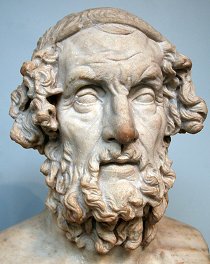
 |
Homer: The Odyssey |
|
| Ancient Greek text and translations presented by the Classics Reader |
|
Please note: The above is
only an image. Click on it to move to the page in which you can interact
with the program Classics Reader. |
 Homer (from the British Museum) |
Homer is the purported author of The Odyssey (and also of The Iliad), who presumably lived some time in the 8th or 7th century BC. His existence is disputed by some scholars who see inconsistences in the two epic poems, but supported by others who see the overal consistency and argue that the poems can only be the work of a single genius. What is definitely known is that both The Iliad and The Odyssey underwent a process of standardization and refinement, especially during the times of the Athenian tyrant Hipparchus (6th C. BC), who reformed the recitation of Homeric poetry. Almost nothing is known about Homer. The Aegean island of Chios, and ancient Greek cities in the west coast of Asia Minor (today’s Turkey) have claimed to be his birthplace. When the Roman emperor Hadrian asked the Oracle at Delphi who Homer really was, Pythia answered that he was from Ithaca, the son of Telemachus and Epikaste (Telemachus was the son of Odysseus). If Homer existed, he was probably a blind bard, which is inferred from an incident assumed to be self-referential in Rhapsody Θ (8), in which the blind bard Demodocus sings for the Phaeacian king and public. |
|
The poem recounts the 10-year-long journey of king Odysseus, from the battlefields of Troy to his kingdom in Ithaca (a little island off the west coast of Greece). It starts in the middle of Odysseus’s journey, when his son Telemachus travels to nearby kingdoms inquiring about his father, whereas Odysseus finds himself on the island of the Phaeacians and recounts prior events of his journey. However, back in Ithaca, suitors are courting his wife, queen Penelope, and are wasting his property staying at his palace and trying to persuade Penelope to choose and marry one among them. Meanwhile, with the help of the Phaeacians and of goddess Athene, Odysseus prepares to return home. The following is an interesting depiction of the Mediterranean world as imagined by ancient Greeks at Homer’s time (this image used to reside in Wikipedia, but was later removed):
Map of landmark places mentioned in The Odyssey The above figure, although it grossly misrepresents reality, can be used as a reference while reading about Odysseus’s journey (which, after all, did not correspond to reality). |
For comments, suggestions, or other correspondence please contact the author of this page. Click here to email to him.